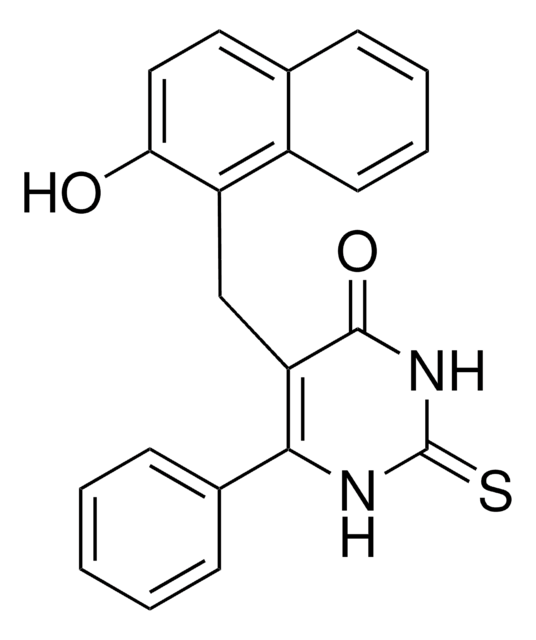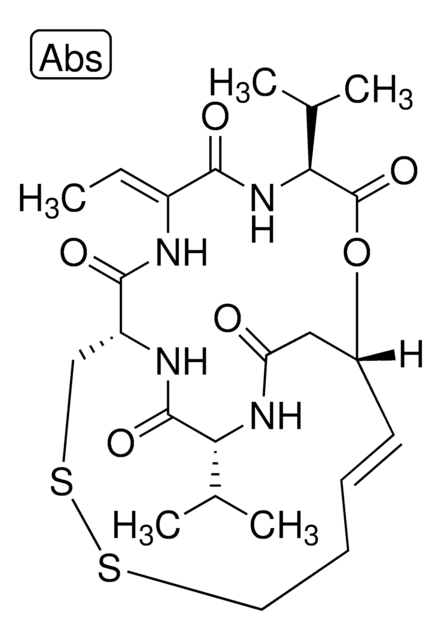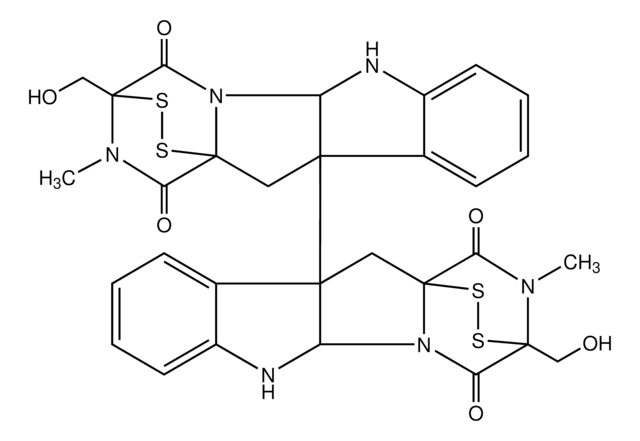すべての画像(1)
About This Item
実験式(ヒル表記法):
C26H22N2O2
CAS番号:
分子量:
394.47
MDL番号:
UNSPSCコード:
12352200
PubChem Substance ID:
NACRES:
NA.77
おすすめの製品
品質水準
アッセイ
≥98% (HPLC)
フォーム
powder
保管条件
desiccated
色
yellow
溶解性
DMSO: >10 mg/mL
保管温度
2-8°C
SMILES記法
CC(C(=O)Nc1cccc(c1)\N=C\c2c(O)ccc3ccccc23)c4ccccc4
InChI
1S/C26H22N2O2/c1-18(19-8-3-2-4-9-19)26(30)28-22-12-7-11-21(16-22)27-17-24-23-13-6-5-10-20(23)14-15-25(24)29/h2-18,29H,1H3,(H,28,30)/b27-17+
InChI Key
HQSSEGBEYORUBY-WPWMEQJKSA-N
アプリケーション
Salermide was used to treat human pulmonary artery smooth muscle cells to study the effect of SIRT1 inhibition on expression of atrogin by qPCR.1
生物化学的/生理学的作用
サレルミドはサーチュイン1(Sirt1)およびサーチュイン2(Sirt2)の新規インヒビターです(クラスIIIヒストン脱アセチル化酵素インヒビター)。In vitroにおいてサレルミドはSirt1よりもSirt2に強い阻害効果を示します。サレルミドは腫瘍細胞で広範なアポトーシスを誘導します。この活性は、Sirt1により癌細胞のみにおいてエピジェネティックに抑制されるアポトーシス促進性遺伝子がサレルミドの効果により再活性化されるためとみなされています。サレルミド(salermide)はサーチュインのインヒビターとしてサーチノール(製品番号S7942)よりも強力です。
サレルミドはサーチュイン1(Sirt1)およびサーチュイン2(Sirt2)の新規インヒビターです。サレルミドは、Sirt1により癌細胞のみにおいてエピジェネティックに抑制されるアポトーシス促進性遺伝子を再活性化します。
特徴および利点
This compound is a featured product for Gene Regulation research. Click here to discover more featured Gene Regulation products. Learn more about bioactive small molecules for other areas of research at sigma.com/discover-bsm.
保管分類コード
11 - Combustible Solids
WGK
WGK 3
適用法令
試験研究用途を考慮した関連法令を主に挙げております。化学物質以外については、一部の情報のみ提供しています。 製品を安全かつ合法的に使用することは、使用者の義務です。最新情報により修正される場合があります。WEBの反映には時間を要することがあるため、適宜SDSをご参照ください。
Jan Code
S8825-BULK:
S8825-VAR:
S8825-5MG:
S8825-25MG:
S8825-IP:
Julien Lancelot et al.
PLoS neglected tropical diseases, 7(9), e2428-e2428 (2013-09-27)
The chemotherapy of schistosomiasis currently depends on the use of a single drug, praziquantel. In order to develop novel chemotherapeutic agents we are investigating enzymes involved in the epigenetic modification of chromatin. Sirtuins are NAD+ dependent lysine deacetylases that are
Mohammad Reza Salahshoor et al.
International journal of preventive medicine, 4(12), 1402-1413 (2014-02-06)
Sirtuin1 is an enzyme that deacetylates histones and several non-histone proteins including P53 during the stress. P300 is a member of the histone acetyl transferase family and enzyme that acetylates histones. Hereby, this study describes the potency combination of Salermide
M Nikbakht Dastjerdi et al.
Research in pharmaceutical sciences, 8(2), 79-89 (2013-09-11)
Sirtuin1 (SIRT1) is an enzyme that deacetylates histones and several nonhistone proteins including p53 during stress and plays an important role in the survival of tumor cells. Hereby, this study describes the potency of salermide as a SIRT1 inhibitor to
Qi Zhang et al.
EMBO molecular medicine, 4(4), 298-312 (2012-02-15)
Although ∼50% of all types of human cancers harbour wild-type TP53, this p53 tumour suppressor is often deactivated through a concerted action by its abnormally elevated suppressors, MDM2, MDMX or SIRT1. Here, we report a novel small molecule Inauhzin (INZ)
Shan Huang et al.
Translational oncology, 10(6), 917-927 (2017-10-11)
Hepatocellular carcinoma (HCC) is one of the most common neoplasms, and metastasis is the most important feature for HCC-related deaths. Mounting evidence implies the dynamic regulatory role of SIRT2, a histone deacetylase, in cancer cells. Unfortunately, the role of SIRT2
資料
Epigenetic modifications are thought to occur through two key interconnected processes—DNA methylation and the covalent modification of histones.
ライフサイエンス、有機合成、材料科学、クロマトグラフィー、分析など、あらゆる分野の研究に経験のあるメンバーがおります。.
製品に関するお問い合わせはこちら(テクニカルサービス)








